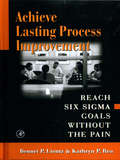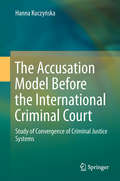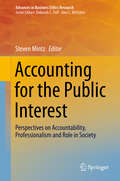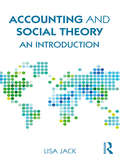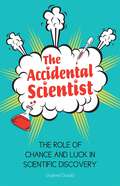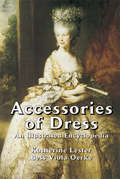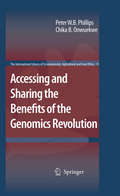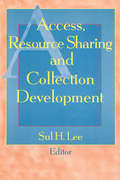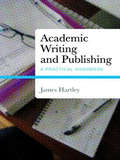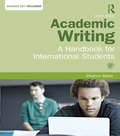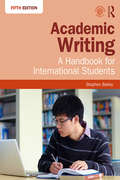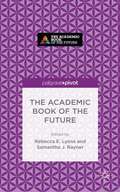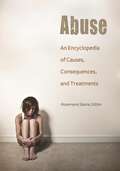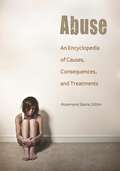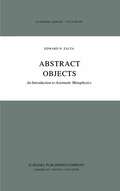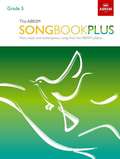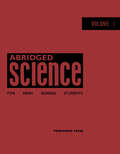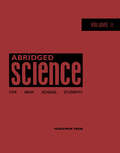- Table View
- List View
Achieve Lasting Process Improvement
by Bennet Lientz Kathryn ReaMethods of improving business processes are developed on an ongoing basis, but few are successful. Common problems encountered include the failure of processes to meet expectations and the inability to sustain or replicate these business processes. Involvement of personnel at grassroots level, as well as at management level, is essential in implementing effective process improvement methods. The authors present a step-by-step approach to the issue of effective process improvement, offering more than 200 tips and guidelines as well as addressing specific common problems and issues. The strategy presented is to take a broad and intuitive, but learned view of process improvement methods, and the tactics expounded are based on guidelines, common faults, and lessons learned. The authors disparage process improvement operations that depend on jargon and the support of just upper management, and promote grassroots involvement and self-sustaining measurement, making this an essential guide for all with involvement in process improvement.
The Accusation Model Before the International Criminal Court: Study of Convergence of Criminal Justice Systems
by Hanna KuczyńskaThis book examines how the functioning of the International Criminal Court has become a forum of convergence between the common law and civil law criminal justice systems. Four countries were selected as primary examples of these two legal traditions: the United States, England and Wales, Germany and Poland. The first layer of analysis focuses on selected elements of the model of accusation that are crucial to the model adopted by the ICC. These are: development of the notion of the prosecutor’s independence in view of their ties to the countries and the Security Council; the nature and limits of the prosecutor’s discretional powers to initiate proceedings before the ICC; the reasons behind the prosecutor’s choice of both defendants and charges; the role the prosecutor plays in the procedure of disclosure of evidence and consensual termination of proceedings; and the determinants of the model of accusation used during trial and appeal proceedings. The second layer of the book consists in an analysis of the motives behind applying particular solutions to create the model of accusation before the ICC. It also shows how the model of accusation gradually evolved in proceedings before the military and ad hoc tribunals: ICTY and ICTR. Moreover, the question of compatibility of procedural institutions is addressed: In what ways does adopting a certain element of criminal procedure, e.g. discretional powers of the prosecutor to initiate criminal proceedings, influence the remaining procedural elements, e.g. the existence of the dossier of a case or the powers of a judge to change the legal classification of the criminal behavior appearing in the indictment?
Accounting for the Public Interest: Perspectives on Accountability, Professionalism and Role in Society (Advances in Business Ethics Research #4)
by Steven MintzThis volume explores the opportunities and challenges facing the accounting profession in an increasingly globalized business and financial reporting environment. It looks back at past experiences of the profession in attempting to meet its public interest obligation. It examines the role and responsibilities of accounting to society including regulatory requirements, increased emphasis on corporate social responsibility, accounting fraud and whistle-blowing implications, internationalization of public interest obligations, and providing the education needed to be successful. The book incorporates an ethical dimension in making these assessments. Its focus is a conceptual, theoretical one drawing on classical philosophy, the sociology of professions, economic theory, and the public interest dimension of accountants as professionals. The authors of papers are long-time contributors to the annual symposium on Research in Accounting Ethics sponsored by the Public Interest Section of the AAA.
Accounting and Social Theory: An introduction
by Lisa JackIs society possible without accounting? In speech or in writing, we communicate actions, plans and decisions using numbers, calculations, words and images. Although accounting research is dominated by quantitative analyses, the role of accounting in society is firmly established over thousands of years. In this concise book, Lisa Jack demonstrates the power of social theory in expanding the value of accounting research. Accounting and Social Theory: An introduction includes advice on research problems as well as guidance on fertile areas for new research. The tools, techniques and developments covered by the author help readers to see social research in accounting as the study of the use, misuse and abuse of accounting communications by people and the effects that this has on social relationships. Stories of accounting in war, agriculture and food, gender, health and other areas illustrate the ways in which the threads of accounting run through society. Having emerged from the author’s wealth of teaching experience, this book provides a student-focused treasure trove that illuminates the field for early-career researchers in accounting and established academics looking to expand the impact of their work.
Accounting and Social Theory: An introduction
by Lisa JackIs society possible without accounting? In speech or in writing, we communicate actions, plans and decisions using numbers, calculations, words and images. Although accounting research is dominated by quantitative analyses, the role of accounting in society is firmly established over thousands of years. In this concise book, Lisa Jack demonstrates the power of social theory in expanding the value of accounting research. Accounting and Social Theory: An introduction includes advice on research problems as well as guidance on fertile areas for new research. The tools, techniques and developments covered by the author help readers to see social research in accounting as the study of the use, misuse and abuse of accounting communications by people and the effects that this has on social relationships. Stories of accounting in war, agriculture and food, gender, health and other areas illustrate the ways in which the threads of accounting run through society. Having emerged from the author’s wealth of teaching experience, this book provides a student-focused treasure trove that illuminates the field for early-career researchers in accounting and established academics looking to expand the impact of their work.
The Accidental Scientist: The Role of Chance and Luck in Scientific Discovery
by Graeme DonaldHave you ever wondered how the ideas for some things come about? Surprisingly often it is as much down to chance as a single person's brilliance. The Accidental Scientist explores the role of chance and error in scientific, medical and commercial innovation, outlining exactly how some of the most well-known products, gadgets and useful gizmos came to be. From the jacuzzi to jeans and TNT to Tipp-Ex, this book explores many of the discoveries that we are all so familiar with today, yet have the most interesting origins because of the story behind them. Not all discoveries require brilliance, and as The Accidental Scientist demonstrates, sometimes a special ingredient is needed: luck.
Accessories of Dress: An Illustrated Encyclopedia
by Bess Viola Oerke Katherine LesterDrawing upon a vast number of historical sources, the authors of this useful reference have created an entertaining account of the forms of personal adornment men and women have used throughout the ages to enhance their wearing apparel. From hats, veils, wigs, and cosmetics, to cravats, shawls, shoes, and gloves, to walking sticks, handbags, fans, and furs, the engaging commentary displays the humor and personal charm of the many-sided story of accessorized apparel. 644 figures and 59 plates.
Accessing and Sharing the Benefits of the Genomics Revolution (The International Library of Environmental, Agricultural and Food Ethics #11)
by Peter W. B. Phillips Chika B. OnwuekweThis volume explores the legal, economic and political debate over intellectual property rights for traditional knowledge and genetic resources, analyzing theory and practice of access and benefits sharing around the world. The book investigates current flashpoints — the battle between Monsanto and Percy Schmeiser over farmers’ rights; disputes over coexistence of genetically modified and organic produce; and ownership and control of human genetic materials stored in human gene banks around the world.
Accessible E-Content Creation Standards and Guidelines
by Bookshare XrcvcThis document/book lists the standards of and provides guidelines on creating accessible e-content from Mircosoft Word. These standards are intended to help NGOs, libraries, book production agencies and volunteers prepare a digital copy of books in Microsoft Word with a view to further convert it to accessible formats such as EPUB, accessible PDF and DAISY formats with minimal modifications.
Access, Resource Sharing and Collection Development
by Sul H LeeAccess, Resource Sharing, and Collection Development explores the role of libraries in acquiring, storing, and disseminating information in different formats to help you better use technology to share scarce resources and connect library users with collections. With an expressed goal of encouraging continued debate and further investigation, this book provides you with developing strategies and procedures to meet the challenges you face as a collection development librarian during this dynamic time. Among the vital concerns addressed are the competition for limited resources, trends in document delivery, the evaluation of document delivery products, and libraries’options for the future.The chapters collected in Access, Resource Sharing, and Collection Development represent the proceedings of the annual conference held by the University of Oklahoma Libraries and the University of Oklahoma Foundation. The book provides insight into your peers’findings and ideas on: access vs. ownership the future role of the bibliographer changes in collection management managing restrained resource budgets an emphasis on the library user as customer the growth and acceptance of document delivery as a component of collection development and ILL electronic publishing and copyright issues commercial document delivery services Access, Resource Sharing, and Collection Development also shows you how to discover and evaluate "free" resources on the Internet, as standards for production, promotion, and maintenance are nonexistent. The challenge of using these materials is being met by developing criteria for selection, looking at cataloging options, and working in cooperation with other institutions. You’ll also learn the different options for document delivery and how to evaluate document delivery products. Among the book’s advice: you should consider the types of document delivery available, examine the benefits of combining outside services with in-house systems, review the criteria for selecting technologies and suppliers, and explore examples of institutions creating customized systems.
Access, Resource Sharing and Collection Development
by Sul H LeeAccess, Resource Sharing, and Collection Development explores the role of libraries in acquiring, storing, and disseminating information in different formats to help you better use technology to share scarce resources and connect library users with collections. With an expressed goal of encouraging continued debate and further investigation, this book provides you with developing strategies and procedures to meet the challenges you face as a collection development librarian during this dynamic time. Among the vital concerns addressed are the competition for limited resources, trends in document delivery, the evaluation of document delivery products, and libraries’options for the future.The chapters collected in Access, Resource Sharing, and Collection Development represent the proceedings of the annual conference held by the University of Oklahoma Libraries and the University of Oklahoma Foundation. The book provides insight into your peers’findings and ideas on: access vs. ownership the future role of the bibliographer changes in collection management managing restrained resource budgets an emphasis on the library user as customer the growth and acceptance of document delivery as a component of collection development and ILL electronic publishing and copyright issues commercial document delivery services Access, Resource Sharing, and Collection Development also shows you how to discover and evaluate "free" resources on the Internet, as standards for production, promotion, and maintenance are nonexistent. The challenge of using these materials is being met by developing criteria for selection, looking at cataloging options, and working in cooperation with other institutions. You’ll also learn the different options for document delivery and how to evaluate document delivery products. Among the book’s advice: you should consider the types of document delivery available, examine the benefits of combining outside services with in-house systems, review the criteria for selecting technologies and suppliers, and explore examples of institutions creating customized systems.
Acceptable Methods of Aircraft Inspections and Repair: AC 43.13-1B/2B
by Federal Aviation AdministrationThis advisory circular (AC) contains methods, techniques, and practices acceptable to the Administrator for the inspection and repair of nonpressurized areas of civil aircraft, only when there are no manufacturer repair or maintenance instructions. This data generally pertains to minor repairs. The repairs identified in this AC may only be used as a basis for FAA approval for major repairs.
Academic Writing and Publishing: A Practical Handbook
by James HartleyAcademic Writing and Publishing will show academics (mainly in the social sciences) how to write and publish research articles. Its aim is to supply examples and brief discussions of recent work in all aspects of the area in short, sharp chapters. It should serve as a handbook for postgraduates and lecturers new to publishing. The book is written in a readable and lively personal style. The advice given is direct and based on up-to-date research that goes beyond that given in current textbooks. For example, the chapter on titles lists different kinds of titles and their purposes not discussed in other texts. The chapter on abstracts instructs the reader on writing structured abstracts from the start.
Academic Writing and Publishing: A Practical Handbook
by James HartleyAcademic Writing and Publishing will show academics (mainly in the social sciences) how to write and publish research articles. Its aim is to supply examples and brief discussions of recent work in all aspects of the area in short, sharp chapters. It should serve as a handbook for postgraduates and lecturers new to publishing. The book is written in a readable and lively personal style. The advice given is direct and based on up-to-date research that goes beyond that given in current textbooks. For example, the chapter on titles lists different kinds of titles and their purposes not discussed in other texts. The chapter on abstracts instructs the reader on writing structured abstracts from the start.
Academic Writing: A Handbook for International Students
by Stephen BaileyMost international students need to write essays and reports for exams and coursework, but writing good academic English is one of the most demanding tasks students face. This new, fourth edition of Academic Writing: A Handbook for International Students has been completely revised to help students reach this goal. The four main parts of Academic Writing are: The writing process Elements of writing Vocabulary for writing Writing models Each part is divided into short units which contain examples, explanations and exercises, for use in the classroom or for self-study. The units are clearly organised to allow teachers and students find the help they need with writing tasks, while cross-referencing allows easy access to relevant sections. In the first part, each stage of the writing process is demonstrated and practised, from selecting suitable sources, reading, note-making and planning through to re-writing and proof-reading. The fourth edition of this popular course builds on the success of the earlier editions, and has a special focus on the vital topic of academic vocabulary in part three, Vocabulary for Writing. Part three deals with areas such as nouns and adjectives, adverbs and verbs, synonyms, prefixes and prepositions, in an academic context. More key features of the book include: All elements of writing are clearly explained, with a full glossary for reference Models provided for all types of academic texts: essays, reports, reviews and case-studies Full range of practice exercises, with answer key included Use of authentic academic texts A companion website offers further practice with a range of additional exercises Fully updated, with sections on finding electronic sources and evaluating internet material All international students wanting to maximise their academic potential will find this practical and easy-to-use book an invaluable guide to writing in English for their degree courses.
Academic Writing: A Handbook for International Students
by Stephen BaileyMost international students need to write essays and reports for exams and coursework, but writing good academic English is one of the most demanding tasks students face. This new, fourth edition of Academic Writing: A Handbook for International Students has been completely revised to help students reach this goal. The four main parts of Academic Writing are: The writing process Elements of writing Vocabulary for writing Writing models Each part is divided into short units which contain examples, explanations and exercises, for use in the classroom or for self-study. The units are clearly organised to allow teachers and students find the help they need with writing tasks, while cross-referencing allows easy access to relevant sections. In the first part, each stage of the writing process is demonstrated and practised, from selecting suitable sources, reading, note-making and planning through to re-writing and proof-reading. The fourth edition of this popular course builds on the success of the earlier editions, and has a special focus on the vital topic of academic vocabulary in part three, Vocabulary for Writing. Part three deals with areas such as nouns and adjectives, adverbs and verbs, synonyms, prefixes and prepositions, in an academic context. More key features of the book include: All elements of writing are clearly explained, with a full glossary for reference Models provided for all types of academic texts: essays, reports, reviews and case-studies Full range of practice exercises, with answer key included Use of authentic academic texts A companion website offers further practice with a range of additional exercises Fully updated, with sections on finding electronic sources and evaluating internet material All international students wanting to maximise their academic potential will find this practical and easy-to-use book an invaluable guide to writing in English for their degree courses.
Academic Writing: A Handbook for International Students
by Stephen BaileyNow in its fifth edition, Academic Writing helps international students succeed in writing essays and reports for their English-language academic courses. Thoroughly revised and updated, it is designed to let teachers and students easily find the topics they need, both in the classroom and for self-study. The book consists of five parts: The Writing Process Elements of Writing Language Issues Vocabulary for Writing Writing Models The first part explains and practises every stage of essay writing, from choosing the best sources, reading and note-making, through to referencing and proofreading. The four remaining parts, organised alphabetically, can be taught in conjunction with the first part or used on a remedial basis. A progress check at the end of each part allows students to assess their learning. All units are fully cross-referenced, and a complete set of answers to the practice exercises is included. New topics in this edition include Writing in Groups, Written British and American English, and Writing Letters and Emails. In addition, the new interactive website has a full set of teaching notes as well as more challenging exercises, revision material and links to other sources. Additional features of the book include: Models provided for writing tasks such as case studies and essays Use of authentic academic texts from a wide range of disciplines Designed for self-study as well as classroom use Useful at both undergraduate and postgraduate level Glossary to explain technical terms, plus index Written to deal with the specific language issues faced by international students, this practical, user-friendly book is an invaluable guide to academic writing in English.
Academic Writing: A Handbook for International Students
by Stephen BaileyNow in its fifth edition, Academic Writing helps international students succeed in writing essays and reports for their English-language academic courses. Thoroughly revised and updated, it is designed to let teachers and students easily find the topics they need, both in the classroom and for self-study. The book consists of five parts: The Writing Process Elements of Writing Language Issues Vocabulary for Writing Writing Models The first part explains and practises every stage of essay writing, from choosing the best sources, reading and note-making, through to referencing and proofreading. The four remaining parts, organised alphabetically, can be taught in conjunction with the first part or used on a remedial basis. A progress check at the end of each part allows students to assess their learning. All units are fully cross-referenced, and a complete set of answers to the practice exercises is included. New topics in this edition include Writing in Groups, Written British and American English, and Writing Letters and Emails. In addition, the new interactive website has a full set of teaching notes as well as more challenging exercises, revision material and links to other sources. Additional features of the book include: Models provided for writing tasks such as case studies and essays Use of authentic academic texts from a wide range of disciplines Designed for self-study as well as classroom use Useful at both undergraduate and postgraduate level Glossary to explain technical terms, plus index Written to deal with the specific language issues faced by international students, this practical, user-friendly book is an invaluable guide to academic writing in English.
The Academic Book Of The Future (PDF)
by Rebecca E. Lyons Samantha RaynerThis book is open access under a CC-BY licence. Part of the AHRC/British Library Academic Book of the Future Project, this book interrogates current and emerging contexts of academic books from the perspectives of thirteen expert voices from the connected communities of publishing, academia, libraries, and bookselling.
Abuse: An Encyclopedia of Causes, Consequences, and Treatments
by AuThis timely volume shows how abuse impacts every segment of society—and how society is seeking effective ways to respond.Abuse, a key theme of health education curricula, is also a major issue faced by many segments of society. Intended for high school students as well as undergraduates and the general reader, this comprehensive encyclopedia explores abuse in all its forms—physical, sexual, emotional, and verbal—among a variety of age and demographic groups from children to the elderly to the disabled. It sheds light on causes and symptoms of abuse, examines lasting impacts, and suggests avenues for prevention and treatment.Specific topics of concern to a secondary school audience include bullying and cyberbullying; abuse of those in same-sex relationships; and sexual abuse through rape, date rape, incest, and sexting. Elder abuse, which has become of greater concern as our society ages, is covered, as are domestic abuse, child abuse, and abduction. Through up-to-date entries by expert contributors, readers will learn about the causes and results of specific types of abuse, as well as their legal and sociological dimensions. The title will also serve as a gateway to further study—and as a resource for readers seeking help.
Abuse: An Encyclopedia of Causes, Consequences, and Treatments
by Rosemarie SkaineThis timely volume shows how abuse impacts every segment of society—and how society is seeking effective ways to respond.Abuse, a key theme of health education curricula, is also a major issue faced by many segments of society. Intended for high school students as well as undergraduates and the general reader, this comprehensive encyclopedia explores abuse in all its forms—physical, sexual, emotional, and verbal—among a variety of age and demographic groups from children to the elderly to the disabled. It sheds light on causes and symptoms of abuse, examines lasting impacts, and suggests avenues for prevention and treatment.Specific topics of concern to a secondary school audience include bullying and cyberbullying; abuse of those in same-sex relationships; and sexual abuse through rape, date rape, incest, and sexting. Elder abuse, which has become of greater concern as our society ages, is covered, as are domestic abuse, child abuse, and abduction. Through up-to-date entries by expert contributors, readers will learn about the causes and results of specific types of abuse, as well as their legal and sociological dimensions. The title will also serve as a gateway to further study—and as a resource for readers seeking help.
Abstract Objects: An Introduction to Axiomatic Metaphysics (Synthese Library #160)
by E. ZaltaIn this book, I attempt to lay the axiomatic foundations of metaphysics by developing and applying a (formal) theory of abstract objects. The cornerstones include a principle which presents precise conditions under which there are abstract objects and a principle which says when apparently distinct such objects are in fact identical. The principles are constructed out of a basic set of primitive notions, which are identified at the end of the Introduction, just before the theorizing begins. The main reason for producing a theory which defines a logical space of abstract objects is that it may have a great deal of explanatory power. It is hoped that the data explained by means of the theory will be of interest to pure and applied metaphysicians, logicians and linguists, and pure and applied epistemologists. The ideas upon which the theory is based are not essentially new. They can be traced back to Alexius Meinong and his student, Ernst Mally, the two most influential members of a school of philosophers and psychologists working in Graz in the early part of the twentieth century. They investigated psychological, abstract and non-existent objects - a realm of objects which weren't being taken seriously by Anglo-American philoso phers in the Russell tradition. I first took the views of Meinong and Mally seriously in a course on metaphysics taught by Terence Parsons at the University of Massachusetts/Amherst in the Fall of 1978. Parsons had developed an axiomatic version of Meinong's naive theory of objects.
The ABRSM Songbook Plus, Grade 5: More classic and contemporary songs from the ABRSM syllabus (ABRSM Songbooks (ABRSM) Ser.)
by AbrsmA new addition to ABRSM's bestselling Songbook series, ABRSM Songbook Plus features an unrivalled choice of repertoire in a huge variety of styles that will inspire singers of all ages. An essential collection for those preparing for their Grade 5 exam or for anyone who loves to sing. The Grade 1, 2, 3 and 4 books are also available on request.
Abridged Science for High School Students: The Nuclear Research Foundation School Certificate Integrated
by H. MesselAbridged Science for High School Students, Volume I is a general science book that provides a concise discussion of wide array of scientific topics. The book is designed to supplement integrated science courses. The contents of the text cover a wide variety of scientific disciplines and are not structured in any way. The coverage of the book includes discussions on matter, heat, weather, gravity, time, and evolution. The book will be of great interest to anyone who wants to have access to a wide variety of scientific disciplines in one publication.
Abridged Science for High School Students: The Nuclear Research Foundation School Certificate Integrated
by H. MesselAbridged Science for High School Students, Volume II is a general science book that provides a concise discussion of wide array of scientific topics. This is volume sets out to continue where the first volume left off by covering Chapters 22 to 49. The contents of the text cover a wide variety of scientific disciplines and are not structured in any way. The coverage of the book includes discussions on vertebrates and invertebrates, solar system, evolution, electromagnetism, the Earth, the moon, energy, and classification of organisms. The book will be of great interest to anyone who wants to have access to a wide variety of scientific disciplines in one publication.
